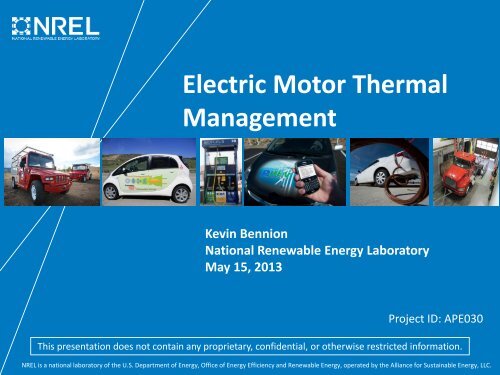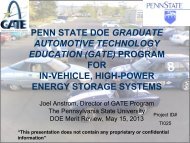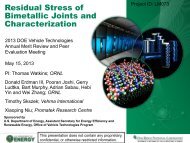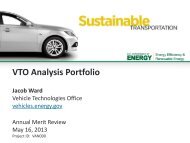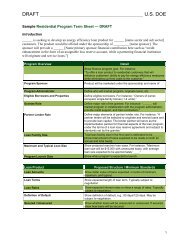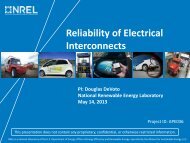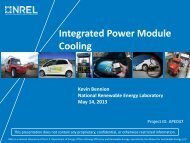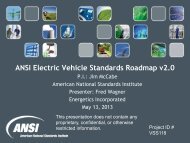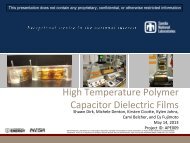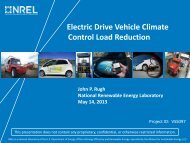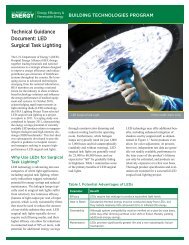Electric Motor Thermal Management - Department of Energy - U.S. ...
Electric Motor Thermal Management - Department of Energy - U.S. ...
Electric Motor Thermal Management - Department of Energy - U.S. ...
You also want an ePaper? Increase the reach of your titles
YUMPU automatically turns print PDFs into web optimized ePapers that Google loves.
<strong>Electric</strong> <strong>Motor</strong> <strong>Thermal</strong><br />
<strong>Management</strong><br />
Kevin Bennion<br />
National Renewable <strong>Energy</strong> Laboratory<br />
May 15, 2013<br />
Project ID: APE030<br />
This presentation does not contain any proprietary, confidential, or otherwise restricted information.<br />
NREL is a national laboratory <strong>of</strong> the U.S. <strong>Department</strong> <strong>of</strong> <strong>Energy</strong>, Office <strong>of</strong> <strong>Energy</strong> Efficiency and Renewable <strong>Energy</strong>, operated by the Alliance for Sustainable <strong>Energy</strong>, LLC.
Overview<br />
Timeline<br />
Project Start Date: FY 2010<br />
Project End Date: FY 2013<br />
Percent Complete: 80%<br />
Budget<br />
Total Project Funding:<br />
DOE Share:$1,900K (FY10-FY13)<br />
Funding Received in FY12: $550K<br />
Funding for FY13: $500K<br />
Barriers and Targets<br />
• Cost<br />
• Weight<br />
• Performance & Life<br />
Partners<br />
• Interactions / Collaborations<br />
– University <strong>of</strong> Wisconsin (UW) – Madison<br />
(Thomas M. Jahns)<br />
– Oak Ridge National Laboratory (ORNL)<br />
– <strong>Motor</strong> Industry Representatives<br />
• Project Lead<br />
– National Renewable <strong>Energy</strong> Laboratory<br />
2
Relevance/Objectives<br />
The transition to more<br />
electrically dominant<br />
propulsion systems<br />
leads to higher-power<br />
duty cycles for electric<br />
drive systems.<br />
Torque<br />
Transient<br />
Operating Limit<br />
Continuous<br />
Operating Limit<br />
<strong>Thermal</strong>ly Limited<br />
Area <strong>of</strong> Operation<br />
Speed<br />
<strong>Thermal</strong> management is needed to reduce<br />
size and improve performance <strong>of</strong> electric<br />
motors.<br />
• Meet/improve power capability within<br />
cost/efficiency constraints<br />
• Reduce rare earth material costs (dysprosium)<br />
Efficiency<br />
(%)<br />
Cost ($/kW)<br />
Targets<br />
Volume (kW/L)<br />
Weight<br />
(kW/kg)<br />
3
Relevance/Objectives<br />
The transition to more<br />
electrically dominant<br />
propulsion systems<br />
leads to higher-power<br />
duty cycles for electric<br />
drive systems.<br />
Torque<br />
Transient<br />
Operating Limit<br />
Continuous<br />
Operating Limit<br />
<strong>Thermal</strong>ly Limited<br />
Area <strong>of</strong> Operation<br />
Speed<br />
Objectives<br />
• Quantify opportunities for improving cooling technologies for electric motors<br />
• Link thermal improvements to their impact on Advanced Power Electronics and<br />
<strong>Electric</strong> <strong>Motor</strong>s (APEEM) targets<br />
• Increase information related to motor thermal management in open literature<br />
Addresses Targets<br />
• Translates cooling performance improvements into impacts on program targets<br />
• Prioritizes motor thermal management efforts based on areas <strong>of</strong> most impact<br />
4
Milestones<br />
Date<br />
January 2012<br />
July 2012<br />
September 2012<br />
December 2012<br />
September 2013<br />
Description<br />
Go/No-Go<br />
• Completed selected motor lamination material thermal property tests<br />
• Decided to not expand material tests at this time<br />
Go/No-Go<br />
• <strong>Thermal</strong> sensitivity analysis showed significant impact common to multiple<br />
motor configurations leading to future project proposals for specific<br />
convective cooling enhancements and passive stack thermal improvements<br />
Milestone report<br />
• Lamination material thermal properties and motor thermal sensitivity<br />
analysis<br />
Milestone (internal)<br />
• Completed transmission oil test bench for oil cooling experiments<br />
Milestone report<br />
• Final project summary report on lamination material thermal properties,<br />
motor thermal sensitivity analysis, and oil heat transfer experimental data<br />
• Summarize collaborative motor cooling efforts with Oak Ridge National<br />
Laboratory (ORNL)<br />
5
Approach/Strategy<br />
FY13 Focus<br />
Credit: Kevin Bennion, NREL<br />
Interior Permanent Magnet (IPM) Model Cross Section<br />
Transmission Oil Heat Transfer Experimental Setup<br />
6
Approach/Strategy<br />
Cooling Technology Selection<br />
• Characterize heat transfer<br />
coefficients <strong>of</strong> oil impingement<br />
cooling<br />
• Investigate wire insulation reliability<br />
o Oil cooling impingement<br />
o High-potential breakdown<br />
voltage tests<br />
Credit: Kevin Bennion, NREL<br />
Oil Impingement Test Chamber<br />
IPM <strong>Motor</strong> Model<br />
IPM <strong>Motor</strong> Cooling Schematic<br />
<strong>Motor</strong> Axis<br />
7
Approach/Strategy<br />
Passive <strong>Thermal</strong> Design<br />
• <strong>Thermal</strong> interfaces between contacting<br />
components provide significant resistance to<br />
heat flow.<br />
• Interfaces are <strong>of</strong>ten difficult to characterize<br />
experimentally.<br />
• Manufacturing variability increases the<br />
uncertainty <strong>of</strong> the interface thermal<br />
resistance.<br />
IPM <strong>Motor</strong> Model Cross Section<br />
8
Approach/Strategy<br />
Passive <strong>Thermal</strong> Design<br />
• <strong>Thermal</strong> interfaces between contacting<br />
components provide significant resistance to<br />
heat flow.<br />
• Interfaces are <strong>of</strong>ten difficult to characterize<br />
experimentally.<br />
• Manufacturing variability increases the<br />
uncertainty <strong>of</strong> the interface thermal<br />
resistance.<br />
• Develop baseline performance data from<br />
analytical and experimental methods.<br />
• Investigate concepts to enhance or improve<br />
effective component thermal properties.<br />
• Improve cooling methods to reduce heat flow<br />
through critical or variable interfaces.<br />
IPM <strong>Motor</strong> Model Cross Section<br />
9
Approach/Strategy<br />
2012<br />
Oct Nov Dec<br />
2013<br />
Jan Feb Mar Apr May Jun Jul Aug Sep<br />
Complete transmission oil loop<br />
construction and preliminary testing<br />
Heat transfer measurements <strong>of</strong> transmission oil jets/sprays and winding<br />
insulation reliability<br />
Milestone<br />
Final Project Report<br />
Continue baseline measurements <strong>of</strong> passive thermal design elements<br />
• Slot Windings<br />
• Laminations<br />
• Contact Interfaces<br />
Credit: Sreekant Narumanchi, NREL<br />
Go/<br />
No-Go<br />
Obtain Baseline Data<br />
for Potential Future<br />
Focus Areas<br />
Legend<br />
Complete<br />
In Progress<br />
Collaboration with ORNL<br />
• <strong>Thermal</strong> analysis and design support<br />
<strong>of</strong> motor developments conducted at<br />
ORNL<br />
ORNL Induction <strong>Motor</strong><br />
10
Technical Accomplishments and Progress<br />
Completed phase one <strong>of</strong> partnership with the University <strong>of</strong> Wisconsin – Madison<br />
• Review <strong>of</strong> thermal analysis and cooling techniques for traction drive motors<br />
• Developed a computationally efficient technique for estimating the loss<br />
components in IPM motors as a function <strong>of</strong> the motor’s operating point<br />
• Developed a 3D finite element analysis (FEA) thermal model for a concentrated<br />
winding stator motor configuration<br />
• Developed a thermal equivalent circuit (TEC) model for an IPM concentrated<br />
winding motor<br />
Concentrated winding motor<br />
Winding<br />
Slot Liner<br />
Credit: Thomas M. Jahns, Seth McElhinney (UW–Madison)<br />
Preliminary thermal FEA showing temperature drop<br />
across slot liner for case cooled machine and thermal<br />
gradients in winding<br />
Comparison <strong>of</strong> TEC model with FEA<br />
temperature predictions<br />
11
Technical Accomplishments and Progress<br />
Initiated phase two <strong>of</strong> partnership with the University <strong>of</strong><br />
Wisconsin – Madison<br />
• Model experimental validation and improvement<br />
• Investigating improved heat spreading methods<br />
Untwisted Wire Bundles<br />
Litz Type 1 Twisted Wire Bundles<br />
170°C Maximum Temperature 139°C Maximum Temperature<br />
(Same Scale)<br />
Preliminary analysis <strong>of</strong> twisted wire bundles show a hot spot<br />
temperature reduction <strong>of</strong> 30°C at rated torque and power<br />
All Images - Credit: Thomas M. Jahns, Seth McElhinney (UW–Madison)<br />
12
Technical Accomplishments and Progress<br />
Slot Winding <strong>Thermal</strong> Conductivity<br />
78% Fill Factor with 20 Gauge Round Wire (Maximum - 20 gauge Fill Factor)<br />
Cross Slot <strong>Thermal</strong><br />
Conductivity<br />
0.11 W/m-K<br />
0.155 W/m-K<br />
• Improvements to the slot filler material have little impact<br />
without improvements to the wire insulation thermal<br />
conductivity.<br />
13
Technical Accomplishments and Progress<br />
Slot Winding <strong>Thermal</strong> Conductivity<br />
70% Fill Factor with 20 Gauge Round - 20 Wire gauge<br />
Cross Slot <strong>Thermal</strong><br />
Conductivity<br />
0.11 W/m-K<br />
0.155 W/m-K<br />
• Improvements to the slot filler material and wire<br />
insulation are needed for reduced fill factors.<br />
14
Technical Accomplishments and Progress<br />
Slot Winding Wire Shape<br />
Cross Slot <strong>Thermal</strong><br />
Conductivity<br />
20 gauge<br />
5.5 mm<br />
• Rectangular wire shows lower thermal conductivity at the same fill factor because <strong>of</strong> the<br />
lower conductivity filler material.<br />
• Benefit <strong>of</strong> rectangular wire is seen if the thickness <strong>of</strong> the filler material boundaries are<br />
reduced.<br />
15
Technical Accomplishments and Progress<br />
Oil Loop Experimental Setup<br />
• Mercon LV Transmission Fluid<br />
• Initial heat transfer tests focused on jet<br />
impingement on target surface<br />
• Future work<br />
• Alternative heat transfer coefficient<br />
measurement techniques<br />
• Expand number <strong>of</strong> jets, target size, and<br />
target surface<br />
• Wire insulation impacts<br />
Alternative Convection Coefficient<br />
Measurement Methods<br />
Test Chamber<br />
Credit: Kevin Bennion, NREL<br />
Jet Orifice<br />
Jet Target<br />
Surface<br />
Thermochromic Liquid<br />
Crystal<br />
Thermocouple Surface<br />
Temperature Estimate<br />
Resistive<br />
Heater<br />
16
Technical Accomplishments and Progress<br />
Credit: Gilbert Moreno, NREL<br />
Area averaged heat transfer coefficient at<br />
50°C fluid temperature<br />
Credit: Gilbert Moreno, NREL<br />
17
Collaboration and Coordination<br />
• University<br />
– University <strong>of</strong> Wisconsin – Madison<br />
o Support with electric motor expertise<br />
• Industry<br />
– <strong>Motor</strong> industry suppliers, end users, and researchers<br />
o Input on research and test plans<br />
• Other Government Laboratories<br />
– Oak Ridge National Laboratory<br />
o Support from benchmarking activities<br />
o Ensure thermal design space is appropriate and modeling assumptions are<br />
consistent with other aspects <strong>of</strong> APEEM research<br />
o Collaboration on motor designs to reduce or eliminate rare-earth materials<br />
– Other Vehicle Technology Office (VTO) areas<br />
o Collaborate with VTO cross-cut effort for combined cooling loops<br />
18
Future Work<br />
Package<br />
Mechanical<br />
Design<br />
<strong>Thermal</strong><br />
Design<br />
Targets<br />
Cooling<br />
Technology<br />
Selection<br />
Package Mechanical Design<br />
• <strong>Thermal</strong> tests <strong>of</strong> interfaces and materials<br />
Credit: Sreekant Narumanchi, NREL<br />
Credit: Gilbert Moreno, NREL<br />
ORNL Induction <strong>Motor</strong><br />
Cooling Technology Selection<br />
• Characterization <strong>of</strong> oil-cooling heat transfer coefficients<br />
• Oil cooling reliability tests (winding insulation)<br />
<strong>Motor</strong> <strong>Thermal</strong> Design Targets<br />
• Collaboration with ORNL<br />
• <strong>Thermal</strong> analysis and design support <strong>of</strong> motor<br />
developments conducted at ORNL<br />
19
Summary<br />
Relevance<br />
• Impacts the transition to more electrically dominant propulsion systems with higher continuous power<br />
requirements<br />
• Enables improved performance <strong>of</strong> non-rare earth motors and supports lower cost through reduction<br />
<strong>of</strong> rare earth materials used to meet temperature requirements (dysprosium)<br />
Approach/Strategy<br />
• Engage in collaborations with motor design experts from industry, university, and national labs<br />
• Perform in-house thermal characterization <strong>of</strong> materials, interface thermal properties, and cooling<br />
techniques<br />
• Collaborating with ORNL to provide motor thermal analysis support on related motor research at<br />
ORNL<br />
Technical Accomplishments<br />
• Completed thermal sensitivity analysis for a range <strong>of</strong> motor configurations and over a range <strong>of</strong><br />
operating conditions in collaboration with the University <strong>of</strong> Wisconsin – Madison<br />
• Evaluated impact <strong>of</strong> winding material improvements leading to future experimental test plans<br />
• Initiated heat transfer characterization tests involving transmission oil<br />
Collaborations<br />
• University <strong>of</strong> Wisconsin – Madison<br />
• Oak Ridge National Laboratory<br />
• <strong>Motor</strong> industry representatives: manufacturers, researchers, and end users (light duty and heavy duty)<br />
20
Acknowledgments:<br />
Susan Rogers and Steven Boyd,<br />
U.S. <strong>Department</strong> <strong>of</strong> <strong>Energy</strong><br />
Andy Wereszczak, John Miller, Tim<br />
Burress, Randy Wiles, and Curt<br />
Ayers, Oak Ridge National<br />
Laboratory<br />
For more information, contact:<br />
Principal Investigator<br />
Kevin Bennion<br />
Kevin.Bennion@nrel.gov<br />
Phone: (303)-275-4447<br />
Team Members:<br />
Justin Cousineau<br />
Douglas DeVoto<br />
Mark Mihalic<br />
Gilbert Moreno<br />
Thomas M. Jahns (UW–Madison)<br />
Seth McElhinney (UW–Madison)<br />
APEEM Task Leader:<br />
Sreekant Narumanchi<br />
Sreekant.Narumanchi@nrel.gov<br />
Phone: (303)-275-4062


